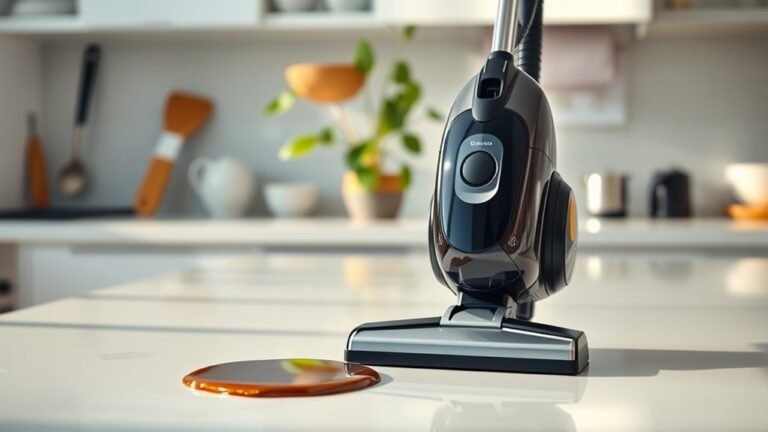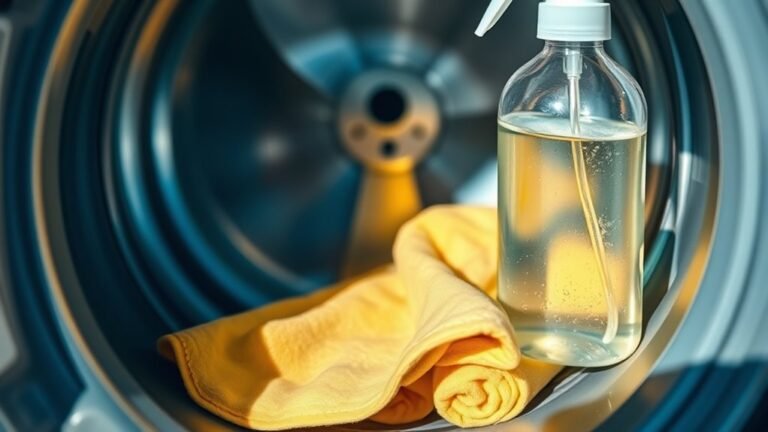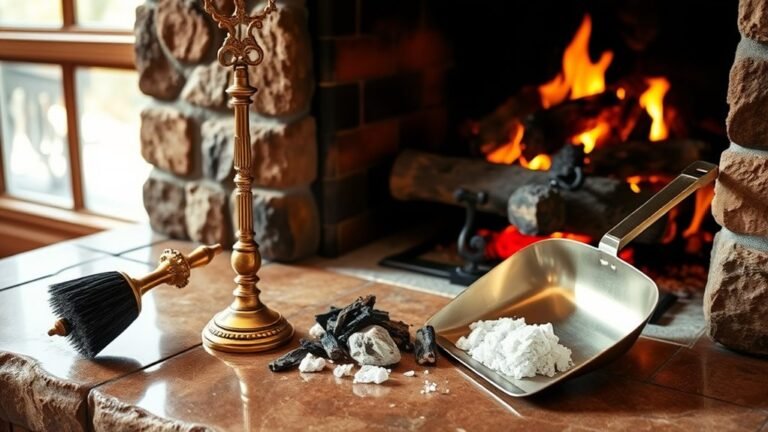Seasonal Maintenance Tips for Oven
You should start by thoroughly cleaning your oven racks and interior, avoiding abrasive tools to protect surfaces. Check your door seals for cracks and replace them if needed to keep heat in and save energy. Test your oven’s temperature accuracy with a thermometer and clean the ventilation system to guarantee proper airflow. Don’t forget to inspect heating elements for damage. For best results, consider scheduling a professional calibration. These simple steps keep your oven efficient and ready for any cooking season.
Inspect and Clean Oven Racks and Interior

Before you plunge into any deep cleaning, take a close look at your oven racks and interior. Noticing grime or burnt residue means it’s time to act. Using the right oven cleaning techniques can free you from tough buildup without harsh scrubbing. Start by removing the racks and soaking them in a mix of warm water and an effective cleaning solution—like baking soda and vinegar—to loosen stuck-on debris. For the interior, avoid abrasive tools; instead, apply a gentle yet powerful cleaner designed for ovens. Wipe down all surfaces thoroughly, ensuring you reach corners where grease hides. Regular attention to these parts keeps your oven performing efficiently and extends its lifespan. You’ll enjoy cooking freely, knowing your oven is fresh and ready.
Check and Replace Oven Door Seals
Once your oven racks and interior are clean, it’s important to turn your attention to the oven door seals. These seals play a critical role in maintaining seal integrity, which directly affects your oven’s heat retention. If the seal is cracked, worn, or missing in spots, heat escapes, making your oven work harder and wasting energy. You want to keep your oven running efficiently to enjoy the freedom of cooking without unnecessary frustration or high bills. Check the seal by closing the door on a piece of paper; if you can pull it out easily, the seal may need replacing. Swapping out a faulty seal is straightforward and restores your oven’s ability to hold heat, so don’t hesitate to replace it when needed.
Test Oven Temperature Accuracy

To make sure your oven is heating correctly, use an oven thermometer to check the actual temperature inside. Compare this reading to the temperature you’ve set on the dial. If there’s a difference, you might need to adjust your oven’s calibration for accurate cooking results.
Use Oven Thermometer
Anyone who cooks regularly knows how important it is to have an accurate oven temperature. Using an oven thermometer is a simple way to guarantee your oven’s heat matches its setting, boosting your cooking efficiency. When you trust your oven accuracy, you gain freedom in your kitchen to experiment and create confidently. Here’s why you should use one:
- Quickly spot temperature fluctuations
- Prevent undercooked or overcooked meals
- Save energy by avoiding unnecessary preheating
- Extend your oven’s lifespan through better use
- Achieve consistent results every time
Compare Set vs. Actual
Knowing why an oven thermometer matters is just the start—you’ll want to check if your oven’s actual temperature matches the one you set. This step is essential for reliable oven performance and guarantees your cooking turns out just right. To compare set vs. actual, place the oven thermometer inside, preheat to a chosen temperature, then wait 15 minutes. Check the thermometer reading against your oven’s display. If there’s a significant difference, note it down on your maintenance checklist. Regularly testing this lets you catch inconsistencies early, preventing ruined meals and wasted energy. Taking charge like this gives you freedom to cook with confidence, knowing your oven is performing as it should. It’s a simple task that’s vital to keeping your oven in top shape.
Adjust Oven Calibration
If your oven’s temperature consistently differs from the set value, adjusting its calibration is the next step to assure accurate cooking. This guarantees your meals turn out just right and saves you from guesswork. To adjust your oven temperature effectively, follow these calibration techniques:
- Use an oven thermometer to measure actual temperature.
- Compare the reading to your oven’s set temperature.
- Locate the calibration dial or digital settings in your oven manual.
- Adjust the temperature setting incrementally based on the difference.
- Recheck with the thermometer after adjustments to confirm accuracy.
Taking control of your oven temperature lets you cook freely without worrying about undercooked or overdone dishes. With these simple calibration techniques, you gain the precision you deserve in your kitchen.
Clean and Maintain Oven Ventilation

Because proper airflow is essential for your oven’s performance and safety, you should regularly clean and maintain its ventilation system. Ventilation systems can easily get clogged with grease, dust, and food particles, which reduces airflow efficiency. When airflow is restricted, your oven works harder, wastes energy, and could even overheat. To keep things running smoothly, start by unplugging the oven and removing any vent covers. Use a soft brush or vacuum to clear debris from vents and fans. Avoid harsh chemicals; mild soap and water usually do the trick. Regular maintenance not only frees you from unexpected breakdowns but also guarantees your oven cooks evenly and safely. Taking control of your oven’s ventilation systems means you’re choosing freedom from costly repairs and inefficient cooking.
Examine Heating Elements and Igniters
One of the most important steps in seasonal oven maintenance is examining the heating elements and igniters to verify they’re functioning properly. A thorough heating element inspection verifies your oven heats evenly and efficiently, saving you time and energy. If you notice any signs of wear or damage, consider an igniter replacement to keep your oven firing up without a hitch. Here’s what to check:
Inspect heating elements and igniters regularly to ensure even, efficient oven performance and prevent unexpected breakdowns.
- Look for cracks, blisters, or breaks on heating elements
- Verify igniters glow steadily without flickering
- Listen for unusual clicking or popping sounds
- Confirm heating elements reach proper temperature quickly
- Check for uneven heating during a test cycle
Regularly inspecting these parts gives you the freedom to cook confidently without unexpected oven failures.
Schedule Professional Oven Calibration
Though your oven may seem to be heating correctly, scheduling a professional calibration guarantees it reaches and maintains the exact temperatures you set. Over time, ovens can drift from their original settings, causing uneven cooking or longer bake times. By using professional services, you ascertain your oven’s thermostat is accurately adjusted, maximizing oven performance and efficiency. This not only improves your cooking results but also gives you the freedom to experiment with recipes without second-guessing temperature accuracy. Don’t settle for guesswork—letting experts calibrate your oven means you can trust every meal turns out just right. Make this a part of your seasonal maintenance routine to keep your oven reliable and your kitchen adventures stress-free.
Prepare Oven for Seasonal Usage Changes
As the seasons shift, your oven’s usage patterns likely change too, so it’s important to adjust its care accordingly. Prepping your oven for seasonal usage changes guarantees you can enjoy seasonal recipes while maintaining energy efficiency. Here’s how you can get started:
Seasonal shifts call for oven care adjustments to enjoy recipes and boost efficiency.
- Deep clean oven interior to remove residue from heavier use.
- Check and replace worn door seals for better heat retention.
- Adjust temperature settings based on typical seasonal cooking needs.
- Inspect and clean oven vents to guarantee proper airflow.
- Test oven light and heating elements for reliable performance.
Frequently Asked Questions
How Often Should I Deep Clean My Oven Annually?
You should aim for at least one annual cleaning to keep your oven in top shape. Regular oven maintenance lets you enjoy freedom from stubborn grime and guarantees your appliance runs efficiently. If you use your oven a lot, you might want to deep clean it twice a year. Sticking to this routine helps prevent buildup and extends your oven’s life, so you can keep cooking freely without worrying about performance issues.
Can I Use Vinegar to Clean My Oven Glass?
Think of your oven glass as a window to culinary adventures; using a vinegar solution is like wiping away the fog of past meals. You can definitely use vinegar for oven cleaning—it’s a natural, effective way to cut through grime without harsh chemicals. Just mix equal parts water and vinegar, spray it on, and let it sit before wiping. This method gives you the freedom to clean safely and keep your kitchen sparkling bright.
What Is the Best Natural Cleaner for Oven Stains?
If you’re after the best natural cleaner for oven stains, you can’t go wrong with baking soda and lemon juice. You’ll sprinkle baking soda over the stains, then spray lemon juice on top to create a fizzy, powerful cleaner. Let it sit for about 15-20 minutes, then wipe away with a damp cloth. This combo cuts through grime without harsh chemicals, giving you freedom to clean your oven safely and effectively.
How Do I Remove Burnt-On Food Without Damaging Surfaces?
When it comes to removing burnt food, you don’t want to throw the baby out with the bathwater. Start by soaking the affected area with a mixture of baking soda and water to loosen the grime. Use gentle cleaning techniques like a soft sponge or nylon scrubber to avoid scratching surfaces. Avoid harsh chemicals, and let patience be your ally—sometimes, freedom from stubborn stains takes a little time and care.
Is It Safe to Self-Repair Oven Electrical Components?
You shouldn’t attempt self-repair on oven electrical components unless you’re trained, as oven safety is essential. Messing with electrical parts can be dangerous and cause further damage. Instead, focus on basic electrical troubleshooting like checking power connections or resetting breakers. If you want freedom and safety, it’s best to call a professional. This way, you avoid risks and guarantee your oven stays in good working order without hassle.






